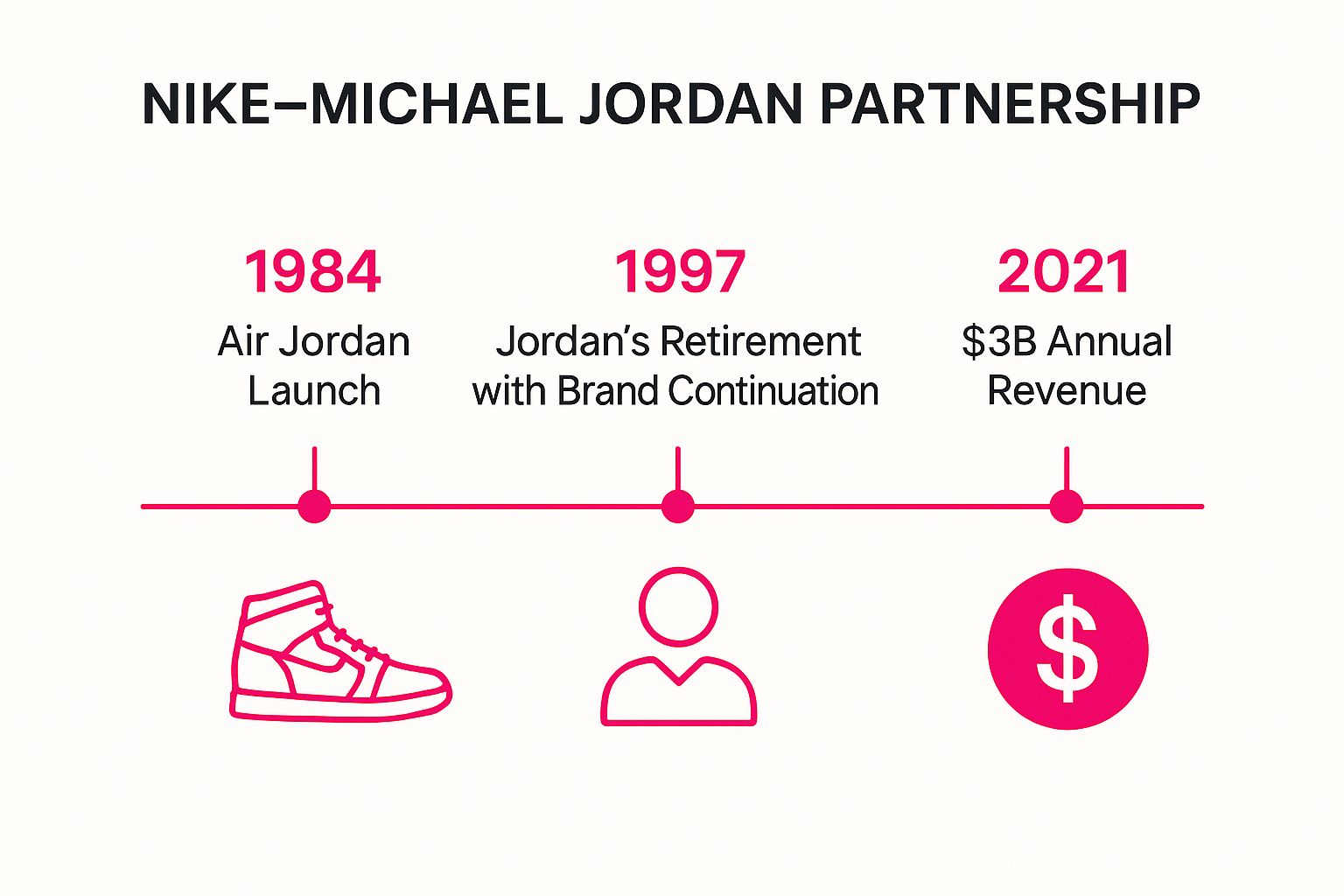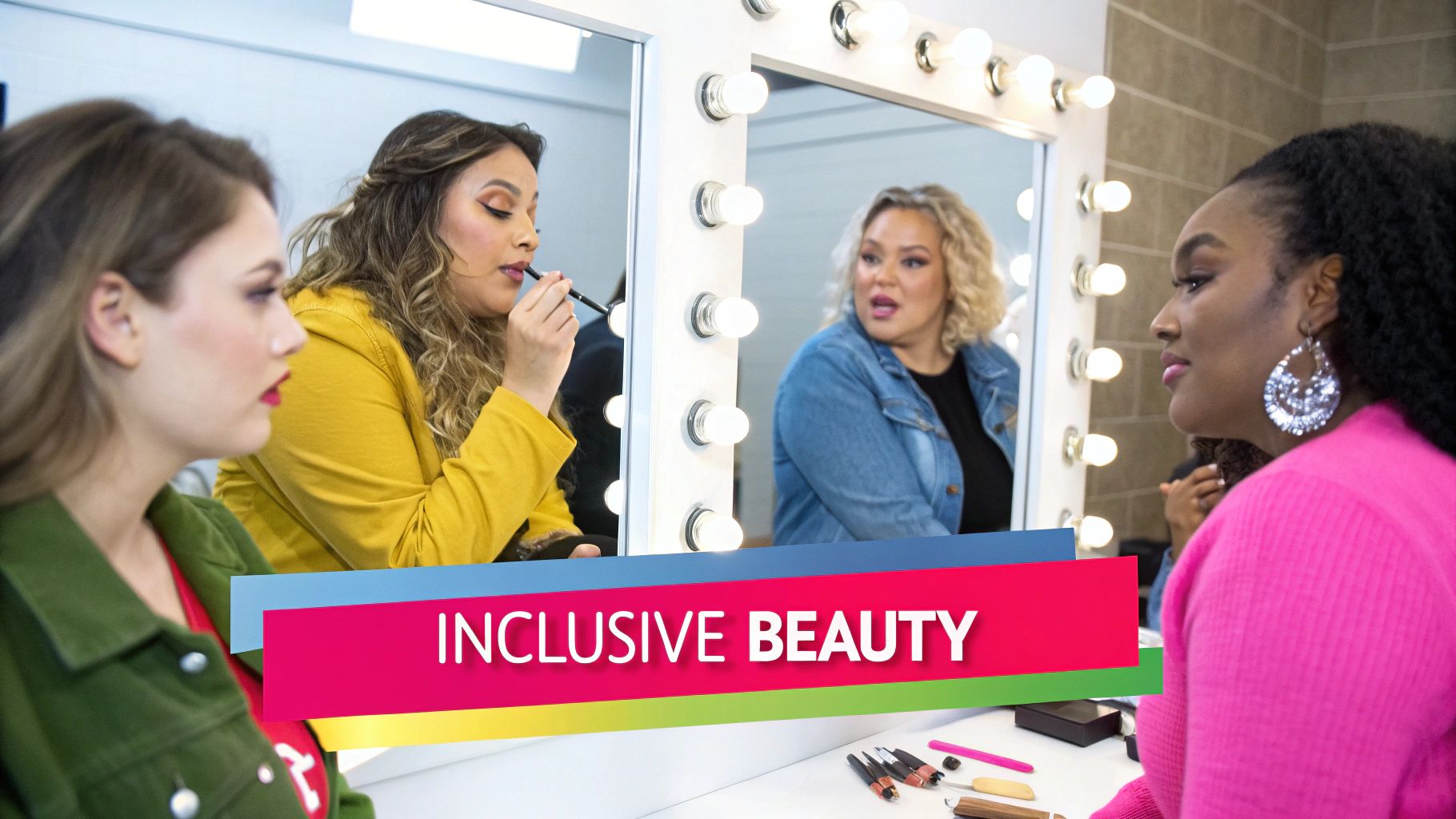Influencer marketing has evolved far beyond simple product placements and sponsored posts. Today, the most successful influencer marketing campaigns are masterclasses in strategic partnership, authentic storytelling, and community building. They don't just generate fleeting buzz; they forge lasting brand affinity, drive measurable growth, and redefine consumer engagement. But what separates a viral triumph from a forgotten ad spend? The difference lies in the strategy, the meticulous planning, and the genuine connection between a brand, its chosen creator, and their audience.
This article moves beyond surface-level praise to dissect the strategic architecture behind iconic campaigns. We will analyse the precise tactics used by giants like Nike and Fenty Beauty, and disruptors such as Gymshark and Glossier. You will gain actionable insights into how these brands selected their partners, structured their collaborations, and measured their impact. We will explore everything from cultivating long-term ambassador communities to leveraging micro-influencers for authentic reach. To further explore the characteristics of effective campaigns and draw inspiration, you can delve into more Instagram influencer success stories. By understanding the replicable frameworks behind these successes, you can equip your own business with a proven blueprint for impactful influencer collaborations.
1. Nike's Air Jordan Partnership with Michael Jordan
The collaboration between Nike and Michael Jordan, which began in 1984, isn't just a campaign; it's the blueprint for modern influencer marketing. It transformed athletic endorsements from simple product placements into powerful, brand-building partnerships. This historic deal created a standalone sub-brand, the Jordan Brand, which now generates billions annually, proving the immense potential of long-term, authentic influencer relationships. This is a premier example of successful influencer marketing campaigns that transcend simple promotion to create a cultural legacy.
Strategic Breakdown
The genius of this partnership lies in its foundation of authenticity and shared risk. Nike didn't just pay a rising star to wear its shoes; it invested in building a brand around Michael Jordan himself. By giving him a signature shoe line, creative input, and a revenue share, Nike empowered its influencer, turning him into a true business partner.
Key Strategy: Nike shifted the paradigm from a transactional endorsement to a relational partnership. They built the product around the influencer's persona, not the other way around. This created an authentic connection that resonated deeply with consumers who wanted to "Be Like Mike."
The timeline below highlights key milestones that illustrate the partnership's evolution from a bold bet to a global empire.

This progression demonstrates how a long-term vision allowed the brand to thrive even after its namesake influencer retired from the sport.
Actionable Takeaways for Your Brand
- Prioritise Authenticity: Partner with influencers who genuinely align with your brand's values and would use your product regardless of a sponsorship.
- Build Long-Term Relationships: Instead of one-off posts, consider multi-year collaborations that allow the influencer's story and your brand's story to grow together.
- Empower Your Influencer: When feasible, offer creative control or even a stake in the success of the campaign. This fosters a deeper commitment and more genuine promotion.
- Focus on Storytelling: Use the partnership to build a narrative that connects with your audience on an emotional level, as explored in other powerful social media campaign examples. This creates a much stronger bond than simply showcasing product features.
2. Daniel Wellington's Instagram Influencer Strategy
Swedish watch brand Daniel Wellington (DW) executed one of the most definitive and successful influencer marketing campaigns of the Instagram era. Launched in 2011, the brand grew from a modest startup into a global powerhouse, reaching over $200 million in revenue largely by pioneering a scalable influencer model. They strategically partnered with thousands of micro and macro-influencers, transforming their minimalist watches into a must-have accessory for a generation.

This campaign is a masterclass in using social media to build brand ubiquity and desirability from the ground up, proving that a high volume of authentic, user-generated-style content can be more powerful than a few high-budget celebrity endorsements.
Strategic Breakdown
Daniel Wellington’s success was built on a foundation of scale and aesthetic consistency. Instead of targeting only A-list celebrities, they armed a massive network of lifestyle influencers with free watches and unique discount codes. This approach democratised influence, creating an omnipresent feel on Instagram feeds globally. The brand maintained strict aesthetic control, ensuring every post reflected its clean, aspirational, and minimalist identity.
Key Strategy: Daniel Wellington focused on product seeding at a massive scale, trading product for exposure. By providing personalised discount codes, they could directly track the ROI of each influencer, creating a performance-based marketing engine that was both scalable and cost-effective.
This focus on a consistent visual language, amplified by thousands of diverse voices, made the watches seem both aspirational and accessible, a core reason for its viral growth.
Actionable Takeaways for Your Brand
- Start with Micro-Influencers: Leverage influencers with smaller, highly engaged followings. Their recommendations often feel more authentic and can deliver a better return on investment, especially for new brands.
- Maintain a Cohesive Brand Aesthetic: Provide clear visual guidelines to your partners to ensure all influencer-generated content aligns with your brand’s look and feel, creating a unified brand presence.
- Use Trackable Discount Codes: Assign a unique promo code to each influencer. This is a simple yet powerful way to measure direct sales and identify your most effective partners.
- Embrace Product Seeding: For brands with attractive, relatively low-cost products, sending free items in exchange for posts can be a highly effective way to generate authentic content and widespread awareness without a large upfront marketing budget.
3. Fenty Beauty's Inclusive Influencer Campaign
Rihanna's Fenty Beauty launch in 2017 didn't just introduce new products; it fundamentally disrupted the beauty industry by championing inclusivity. The campaign’s core was a strategic partnership with a diverse roster of influencers, particularly those from underrepresented communities, to showcase its groundbreaking 40-shade foundation range. This approach addressed a significant, long-ignored gap in the market, generating unprecedented social media engagement and cementing Fenty's status as a brand for everyone. This is a masterclass in how successful influencer marketing campaigns can be built on a foundation of authentic representation.

Strategic Breakdown
The brilliance of Fenty's launch was its message: "Beauty for All". Instead of relying on a few mainstream celebrities, the brand collaborated with influencers across a spectrum of skin tones, ethnicities, and follower counts. By featuring prominent voices like Jackie Aina and Nyma Tang, who had long advocated for more diversity in beauty, Fenty demonstrated a genuine understanding of its audience's frustrations. The campaign felt less like marketing and more like a movement.
Key Strategy: Fenty Beauty built its campaign around a core product truth, its expansive shade range, and used influencer marketing to validate that truth authentically. The focus was on empowerment and representation, turning consumers into brand evangelists.
The strategy's success was amplified by user-generated content, as thousands of customers shared their perfect shade matches online, creating a viral wave of earned media that traditional advertising could never replicate.
Actionable Takeaways for Your Brand
- Solve a Real Problem: Identify a genuine gap or pain point in your market. Fenty’s success came from addressing the beauty industry's failure to cater to diverse skin tones.
- Embrace Authentic Representation: Partner with influencers who truly reflect the community you want to serve. Your commitment to inclusivity must be genuine and visible in your collaborations.
- Empower Your Community: Encourage and feature user-generated content. When customers see themselves reflected in your marketing, they become your most powerful advocates.
- Let the Product Be the Hero: Ensure your product lives up to the marketing promises. Fenty’s campaign was successful because the 40-shade foundation range was a genuinely high-quality and inclusive product.
4. Gymshark's Fitness Influencer Community
Gymshark's ascent from a garage-based startup to a billion-dollar fitness apparel powerhouse is a masterclass in community-driven influencer marketing. Rather than chasing mainstream celebrities, founder Ben Francis cultivated a "family" of fitness influencers, known as Gymshark Athletes. This strategy transformed brand ambassadors into an authentic, aspirational community that consumers felt a part of, making it one of the most effective and replicable successful influencer marketing campaigns in the e-commerce space.
Strategic Breakdown
The core of Gymshark's strategy was building genuine, long-term relationships before focusing on commercial transactions. They identified rising stars in the fitness world, like Steve Cook and Nikki Blackketter, who already had dedicated followings. By sponsoring them early and integrating them deeply into the brand's fabric, from product feedback to global tours, Gymshark created a powerful sense of loyalty and authenticity that felt less like an advertisement and more like a shared movement.
Key Strategy: Gymshark prioritised community over commercials. They built a brand with influencers, not just through them, fostering a symbiotic relationship where the brand's growth and the influencer's career grew in tandem.
This approach allowed them to connect with niche fitness communities on a deeply personal level. The influencers weren't just models; they were real people sharing their fitness journeys, and Gymshark was the gear that powered them.
Actionable Takeaways for Your Brand
- Build Relationships First: Identify micro or nano-influencers who genuinely love your product category. Engage with them and build a rapport before ever proposing a formal partnership.
- Focus on Niche Communities: Don't try to appeal to everyone. Partner with influencers who are trusted authorities within a specific subculture to build credibility and drive higher engagement.
- Empower Your Ambassadors: Involve your key influencers in the product development process. Their insights can be invaluable, and their involvement makes the eventual promotion far more authentic.
- Create a Sense of Belonging: Use your influencer partnerships to build a community. This approach is fundamental to social media marketing for startups and helps transform customers into loyal advocates.
5. Old Spice's Viral Video Campaign with Isaiah Mustafa
The 2010 Old Spice campaign, "The Man Your Man Could Smell Like," is a masterclass in revitalizing a legacy brand for a new generation. Featuring actor Isaiah Mustafa, this campaign masterfully blended traditional advertising with pioneering social media interaction. It didn't just sell body wash; it created a cultural moment, catapulting an outdated brand into the epicentre of viral internet culture and demonstrating the power of humour in successful influencer marketing campaigns.
Strategic Breakdown
Old Spice and its agency, Wieden+Kennedy, took a huge creative risk by moving away from traditional masculine advertising tropes. Instead, they created a charismatic, surreal, and hilarious character. The initial commercial was designed for maximum shareability with its quick-witted script and seamless single-take illusion, but the real genius was the follow-up strategy. The brand leveraged the initial success by creating a real-time response campaign.
Key Strategy: Old Spice bridged the gap between a mass-media broadcast and one-to-one social engagement. By using their influencer, Isaiah Mustafa, to create personalized video responses to fans on social media, they made a massive audience feel seen and heard, fostering unprecedented brand loyalty and conversation.
This two-phased approach ensured the campaign wasn't just a fleeting viral hit but an interactive phenomenon that dominated online conversations.
The original ad laid the foundation, but the personalized social media blitz solidified its legendary status.
Actionable Takeaways for Your Brand
- Create a Memorable Persona: A strong, unique character can be more powerful than a famous celebrity. Focus on personality and storytelling to make your influencer unforgettable.
- Merge Traditional and Social: Use high-production ads to capture broad attention, then follow up with agile, low-cost social content to deepen engagement with your core audience.
- Embrace Real-Time Interaction: When possible, responding directly and creatively to your audience can generate immense goodwill and organic reach. It shows the brand is listening.
- Don't Fear Creative Risks: This campaign’s success was built on breaking the mould. A bold, humorous, or unexpected creative direction can cut through the noise and redefine a brand’s image.
6. Airbnb's Travel Influencer Partnerships
Airbnb revolutionised the travel industry not just with its platform, but with its marketing. By prioritising authentic storytelling from real travellers, the brand built a global community around shared experiences. Instead of relying on traditional advertising, Airbnb partners with travel and lifestyle influencers, providing them with unique stays in exchange for genuine content. This strategy perfectly showcases their core value proposition: living like a local, not a tourist. The result is a powerful collection of user-generated content that serves as one of the most effective and successful influencer marketing campaigns in the hospitality sector.
Strategic Breakdown
The core of Airbnb's success is its focus on experience over promotion. The brand understands that a stunning photo of an influencer in a unique treehouse or a city loft tells a more compelling story than any scripted ad ever could. By gifting stays, Airbnb empowers influencers to create organic content that highlights the very essence of the platform-authentic, unique, and memorable travel. This turns influencers into genuine brand advocates whose experiences resonate deeply with their followers.
Key Strategy: Airbnb operates on a model of "show, don't tell." It facilitates authentic travel moments for influencers, allowing the value of the platform to be demonstrated through genuine, user-generated stories rather than direct advertising.
This approach creates a self-sustaining marketing engine. Influencers share their stays, their followers get inspired to book their own trips, and a new wave of user-generated content is created, perpetuating the cycle of authentic promotion.
Actionable Takeaways for Your Brand
- Focus on Experience: Instead of just sending a product, create a memorable experience around it that an influencer will be excited to share.
- Encourage Authentic Storytelling: Give influencers creative freedom. The most powerful content comes from genuine stories, not strict brand messaging or promotional scripts.
- Choose Niche-Specific Influencers: Partner with creators whose audience perfectly aligns with your target customer. A travel blogger's followers are already primed for travel-related content.
- Leverage User-Generated Content (UGC): Actively reshare and repurpose the content created by your influencer partners across your own marketing channels to maximise its reach and impact.
7. Glossier's Customer-to-Influencer Strategy
Glossier flipped the traditional marketing model on its head by building its empire not with celebrity endorsements, but by empowering its own customers. The brand masterfully blurs the line between consumer and influencer, creating a powerful, community-driven ecosystem. By treating every customer as a potential brand advocate and actively showcasing their content, Glossier fosters an authentic, peer-to-peer trust that feels more like a friend's recommendation than a corporate advertisement. This approach is a masterclass in modern, successful influencer marketing campaigns.
Strategic Breakdown
The core of Glossier's strategy is turning user-generated content into their primary marketing asset. Instead of just selling products, they sell an identity and a community that people want to be part of. Products like the Boy Brow or the iconic pink bubble-wrap pouches are designed to be photogenic and shareable, encouraging customers to post organically. Glossier then amplifies this by reposting customer photos, making everyday users feel seen and valued, effectively turning them into micro-influencers.
Key Strategy: Glossier democratised influence by building a brand with its community, not just for them. Their focus on user-generated content makes every customer a potential spokesperson, creating unparalleled authenticity and scale.
This unique model, where everyday users become brand advocates, demonstrates the power of truly engaging your community, often achieved by leveraging customer-generated content for growth. Glossier’s success shows this isn't just a tactic; it's a foundational business philosophy.
Actionable Takeaways for Your Brand
- Treat Every Customer as an Influencer: Create opportunities for customers to share their experiences and actively engage with their content.
- Design for Shareability: Develop products and packaging with social media in mind. Make your customer's unboxing experience a moment they want to capture and share.
- Build a Genuine Community: Foster a space where customers can connect over shared values, not just your products. Use your social channels for conversation, not just conversion.
- Amplify User-Generated Content: Regularly feature customer photos, reviews, and stories across your official channels. This validates their contribution and encourages others to participate.
8. Dunkin' Donuts Partnership with Charli D'Amelio
The collaboration between Dunkin' and TikTok sensation Charli D'Amelio is a masterclass in leveraging authentic creator affinity to capture the Gen Z market. By turning D'Amelio's genuine, pre-existing love for their coffee into a co-branded product, Dunkin' created a viral sensation. The campaign didn't just feel like an advertisement; it was a natural extension of D'Amelio's personal brand, making it one of the most organic and successful influencer marketing campaigns of the digital age.
Strategic Breakdown
Dunkin's brilliance was in its observation and reaction. They noticed Charli D'Amelio, who at the time was the most-followed creator on TikTok, was constantly featuring their products in her videos organically. Instead of a generic sponsorship, they leaned into this existing behaviour by co-creating "The Charli," her signature cold brew order, and adding it directly to their menu. This transformed her from a passive fan into an active, official partner.
Key Strategy: Dunkin' capitalised on pre-existing, authentic brand advocacy. They didn't have to manufacture a connection; they simply recognised and amplified a genuine one, turning an influencer's daily habit into a national product launch that resonated with millions of her followers.
This approach created a powerful feedback loop. Fans could order the exact same drink as their favourite creator, making them feel more connected to both D'Amelio and the Dunkin' brand.
Actionable Takeaways for Your Brand
- Identify Authentic Advocates: Look for creators who are already using and talking about your products without being paid. These are your most powerful potential partners.
- Co-create Tangible Products: Move beyond sponsored posts by collaborating with influencers to create a product or a special offer. This gives fans a tangible way to participate in the partnership.
- Leverage Platform-Specific Content: The campaign thrived on TikTok-native video formats. Create content that feels natural to the platform where your influencer's audience lives.
- Monitor and Engage in Real-Time: Dunkin's success was partly due to its agility. By listening to social conversations, they were able to pivot and expand the partnership, which can be a key part of brand evolution, similar to the strategies found in major rebranding examples.
Successful Influencer Campaigns: Key Strategies Compared
| Campaign | Implementation Complexity 🔄 | Resource Requirements ⚡ | Expected Outcomes 📊 | Ideal Use Cases 💡 | Key Advantages ⭐ |
|---|---|---|---|---|---|
| Nike's Air Jordan Partnership | High due to long-term collaboration & equity | Very high upfront investment and commitment | Massive revenue ($130B+), multi-generational loyalty | High-budget, long-term athlete endorsements | Authentic influencer alignment, lasting brand legacy |
| Daniel Wellington's Instagram Strategy | Moderate; managing thousands of influencers | Cost-effective, scalable influencer payments | Rapid growth ($200M in 5 years), high engagement | Lifestyle brands targeting broad markets | Cost-effective, scalable, high engagement |
| Fenty Beauty's Inclusive Influencer Campaign | Moderate to high; diverse influencer management | Significant product and campaign investment | Huge early sales ($100M in 40 days), cultural impact | Beauty brands focusing on inclusivity | Industry disruption, authentic representation |
| Gymshark's Fitness Influencer Community | Moderate; building long-term ambassador relations | Lower marketing cost, community management | Billion-dollar valuation, loyal community | Niche fitness apparel targeting enthusiasts | Community-driven, authentic product feedback |
| Old Spice's Viral Video Campaign | High; creative production with real-time engagement | Significant creative resources and coordination | 125% sales increase, viral social media reach | Brands seeking viral content engagement | Highly shareable content, brand revitalization |
| Airbnb's Travel Influencer Partnerships | Moderate; coordinating global influencer network | Cost-effective through accommodation trades | Large user base growth, authentic endorsements | Travel and experience-based businesses | Authentic storytelling, global reach |
| Glossier's Customer-to-Influencer Strategy | Moderate; requires ongoing community management | Significant community management resources | Strong customer loyalty, $1.2B valuation | Brands leveraging peer-to-peer marketing | Authentic content at scale, lower costs |
| Dunkin' Donuts & Charli D'Amelio Partnership | Low to moderate; platform-specific content focus | Moderate; product collaboration & influencer fees | Short-term huge engagement, sales lift | Brands targeting Gen Z via trending social platforms | Authentic influencer affinity, measurable impact |
Crafting Your Own Success Story: Key Principles for High-Impact Campaigns
As we have dissected some of the most successful influencer marketing campaigns in history, from Nike's game-changing partnership with Michael Jordan to Dunkin's viral collaboration with Charli D'Amelio, a clear pattern emerges. True success is not born from simply paying a popular face to hold a product. It is meticulously engineered through authenticity, strategic alignment, and a profound understanding of community.
The campaigns we have explored were not isolated tactics; they were integral components of a larger brand narrative. Fenty Beauty didn’t just hire diverse influencers; it built its entire brand ethos on inclusivity, making its campaign a genuine reflection of its core values. Similarly, Gymshark fostered a real community of fitness athletes, transforming them from paid partners into passionate brand evangelists. This is the new benchmark for excellence.
Core Pillars for Replicable Success
To move from theory to execution, let’s crystalise the essential takeaways that thread through these iconic examples:
- Authenticity is Non-Negotiable: Modern consumers can spot a disingenuous endorsement from a mile away. The partnerships that resonate most deeply, like Airbnb's collaborations with travel storytellers, feel natural because the influencer genuinely aligns with the brand’s mission and product. Prioritise genuine connection over follower count.
- Long-Term Relationships Yield Greater ROI: A one-off post can create a temporary spike, but sustained partnerships, like the decades-long Nike and Jordan collaboration, build lasting brand equity and trust. Investing in long-term ambassador programmes cultivates deeper loyalty and more authentic advocacy.
- Empower Creative Freedom: Your chosen influencers are experts in communicating with their audience. While brand guidelines are necessary, suffocating their creativity with rigid scripts will only produce robotic, ineffective content. Old Spice's campaign with Isaiah Mustafa succeeded because it allowed for a unique, memorable personality to shine through.
- Community is the Ultimate Goal: The most powerful campaigns transform passive viewers into an active community. Glossier brilliantly turned its own customers into its most powerful influencers, creating a self-sustaining ecosystem of user-generated content and authentic recommendations. Think beyond the campaign and focus on building a movement.
Your Next Steps to Influencer Marketing Mastery
The journey to launching your own successful influencer marketing campaigns begins with a strategic mindset. Start not by searching for influencers, but by defining your brand’s story and identifying the communities you want to engage. Analyse what made the examples above resonate so powerfully: the emotional connection, the shared values, and the compelling storytelling.
As you begin to build your own strategy, it's invaluable to study a wide range of approaches. For further insights and diverse examples, explore a comprehensive list of the best influencer marketing campaigns for inspiration, showcasing what truly drives success. By understanding these foundational principles and learning from the triumphs of others, you are no longer just advertising; you are forging meaningful connections that build brands and drive real, sustainable growth.
Ready to move from inspiration to implementation? The expert strategists at Grassroots Creative Agency specialise in crafting bespoke influencer marketing campaigns that deliver measurable results for brands in the UAE and beyond. Let us help you find the authentic voices that will amplify your story and build a thriving community around your brand.








